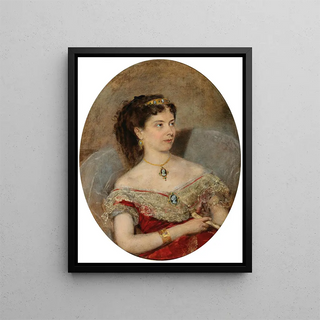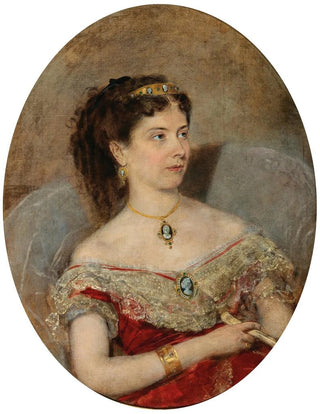Art print | Princess Maria von Stackelberg - Anton Romako Source: Reproduction | Fürstin Maria von Stackelberg - Anton Romako


View from behind

Frame (optional)
Captivating Introduction
The art print "Fürstin Maria von Stackelberg" by Anton Romako is a piece that transcends a simple portrait to capture the very essence of nobility and femininity in the 19th century. In this canvas, the artist manages to create a dialogue between the subject and the viewer, inviting contemplation and admiration. Maria von Stackelberg, an iconic figure of her time, is depicted with grace and dignity that testify not only to her social status but also to the depth of her character. This art print, faithful to the original, allows for rediscovering this masterful work while offering an immersion into Romako's artistic universe.
Style and uniqueness of the work
The work stands out for its delicate color palette and its treatment of light, which confer an almost ethereal aura to Maria von Stackelberg. The subtle nuances of her clothing and the meticulous details of her face reveal an impressive mastery of portrait art. Romako, a true virtuoso, uses chiaroscuro techniques to accentuate the princess's features, creating emotional depth that captures attention. Maria's posture, both relaxed and majestic, conveys a quiet confidence, while her engaging gaze seems to tell a story—the story of a strong and influential woman of her time. This work is not just a portrait but a true window into the soul of its subject, allowing viewers to feel the complexity of her emotions.
The artist and his influence
Anton Romako, born in 1832, was an Austrian painter whose work marked his era with his innovative approach to portraiture. Trained in Europe's major artistic centers, he developed a style that combines realism and romanticism, thus standing out from his contemporaries. His talent for capturing the personality and spirit of his models made him a sought-after artist by nobility and high bourgeoisie. Romako drew inspiration from old masters while infusing modernity into his works, which contributed to his success and recognition. His influence is still felt today, both in the way he redefined portraiture and

Matte finish

View from behind

Frame (optional)
Captivating Introduction
The art print "Fürstin Maria von Stackelberg" by Anton Romako is a piece that transcends a simple portrait to capture the very essence of nobility and femininity in the 19th century. In this canvas, the artist manages to create a dialogue between the subject and the viewer, inviting contemplation and admiration. Maria von Stackelberg, an iconic figure of her time, is depicted with grace and dignity that testify not only to her social status but also to the depth of her character. This art print, faithful to the original, allows for rediscovering this masterful work while offering an immersion into Romako's artistic universe.
Style and uniqueness of the work
The work stands out for its delicate color palette and its treatment of light, which confer an almost ethereal aura to Maria von Stackelberg. The subtle nuances of her clothing and the meticulous details of her face reveal an impressive mastery of portrait art. Romako, a true virtuoso, uses chiaroscuro techniques to accentuate the princess's features, creating emotional depth that captures attention. Maria's posture, both relaxed and majestic, conveys a quiet confidence, while her engaging gaze seems to tell a story—the story of a strong and influential woman of her time. This work is not just a portrait but a true window into the soul of its subject, allowing viewers to feel the complexity of her emotions.
The artist and his influence
Anton Romako, born in 1832, was an Austrian painter whose work marked his era with his innovative approach to portraiture. Trained in Europe's major artistic centers, he developed a style that combines realism and romanticism, thus standing out from his contemporaries. His talent for capturing the personality and spirit of his models made him a sought-after artist by nobility and high bourgeoisie. Romako drew inspiration from old masters while infusing modernity into his works, which contributed to his success and recognition. His influence is still felt today, both in the way he redefined portraiture and






